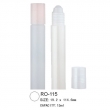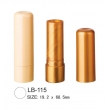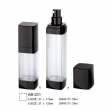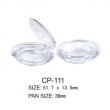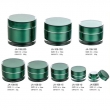Cosmetics/toiletry labelling is arguably one of the industry’s most interesting and challenging sectors. Its special needs have established the combination press and given us the ‘no-label look’ using the latest advances in filmic technology.
Quality and originality are central to the image-conscious cosmetics/toiletries sector. Production commonly involves six or more colours using a mix of mainstream processes and a wide choice of materials. Technically, but also commercially, this business has become much more specialised in recent years. And while accounting for just 5-6 per cent by volume of all self adhesive conversion, it has nevertheless prompted many of the industry’s innovations.
Annual volume growth is 8-10 per cent, which is generally higher than that of the food or pharmaceutical sectors. Labels & Labelling Consultancy also reports that growth is nearer 15 per cent in such markets as men’s toiletries and hair-care products. Annual growth by value is higher at 10 per cent. The total Western European market size for this sector is estimated at around £180 million, but is expected to reach nearer £300 million during the next three or four years.
Of course, self adhesive label converters do not have it all to themselves. Shrink sleeves, film wraps and some in-mould labels are also used with good effect for mass-market toiletry products. In this area, packaging managers also specify huge volumes of metal and plastics containers using one or more direct printing techniques.
Generally, a higher-than-average added value input contributes to the sector’s reputation for earning good profits. But they are well earned. Converters must work closely with their customers, perhaps sourcing materials and carrying out trials to determine printability, compatibility with a container and dispensing properties. Ideally, discussions should start at the idea stage, or at least before repro work begins.
Close collaboration with trade suppliers, including press manufacturers, to iron out likely production problems is essential. Even worse is being asked to hold large stocks of pre-printed labels for call-off, only to see a sudden change in branding requirements during the job’s history. This may involve an unrecoverable loss of revenue, again upholding the general ruthlessness that cosmetics/toiletry packaging buyers have towards all their suppliers.
This sector generally remains competitive, particularly at the mass-market end where the technical price of entry is lower. Here, the intense battles for market shares among manufacturers include retailers’ own-brand products. Label pricing levels are more of an issue, but are less intense than in the food/drinks and general supermarket sectors. The pressure on turning jobs around quickly remains: as elsewhere the accent is on smaller run lengths and just-in-time deliveries. Flexibility is also important in serving a business geared increasingly to seasonal demands and international marketing promotions.
Not surprisingly, converters need specialised expertise and shopfloor skills to produce labels for up-market products. That means investing in up-to date equipment, which tends to favour the larger organisations. Field Packaging Nottingham exemplifies how some companies play for high stakes. It bought the Boots Company’s in-house facility in 1993 and later built a modern factory to produce cartons and labels to ISO 9002 standard. Its equipment is no less state-of-the-art: A Gallus R300 combination press, Aquaflex UV flexo press and a nine-unit version of Nilpeter’s new B200 letterpress/UV flexo machine.
Gary Yates, production manager, confirms the pressure of serving an increasingly competitive market: ‘With delivery times now measured in days, we are having to push our presses to extremes. Shorter runs means we convert 1.7 reels for average jobs. We have also noticed a strong increase in the ‘no-label look’ as an extension of the higher quality standards buyers now expect. Filmics now account for some 80 per cent of our volume and lately we have included multi-layer engineered substrates.
Market profile
As the crowded cosmetics/toiletry shelves of any individual store or supermarket confirm, this market supports hundreds of different products. Strong competition means manufacturers spend fortunes on promoting often high-priced brands to attract sophisticated and fickle consumers. It is a fast-changing industry, with new product launches, new packaging for old products and price pressures that create a tendency towards economy of scale. Where famous brands remain unchanged, presentation becomes even more crucial, with consequent pressures on all aspects of packaging. The pack and labelling must work hard to seduce customers and promote a brand’s carefully nurtured image in well-defined market segments.
It obviously works. Even during recessions, consumers still search for the feel-good factor – however illusionary – by buying expensive fragrances and cosmetics, and also more day-to-day products. France spends over three times as much on perfumes and fragrances and twice as much on cosmetics/toiletries as Germany, Italy and the UK combined. It is no accident that, as in Italy, the top fashion houses now earn more from own-brand fragrances than selling high-ticket garments to a dwindling clientele. French converters therefore figure prominently in this market, although many mass-market products sold in France by global players would have their labels printed elsewhere.
Naturally, fashion and beauty fads play a part, hence the so-called ‘essential’ and ‘natural’ products. The latest skin creams, facial scrubs, lotions and moisturisers reflect a more fashionable minimalist look for make-up throughout much of the developed world. Changing social attitudes and generally higher disposable incomes also reflect more self-indulgence among both sexes in the use of up-market fragrances and toiletries.
End-use markets by value looks something like this, although market shares may vary between different European countries.
A handful of global groups and independents with enormous buying power and clout dominate the business, notably Proctor & Gamble, L’Oreal, Coty, Elida-Gibbs, Gillette, Johnson & Johnson, Avon, max Factor and Rewlon, added to which are the traditional French fragrance houses of varying size and influence, while supermarket groups work with repackagers to create their own brands.
Franchise organisations like the Body Shop add further diversity. It pioneered selling organically-based products with minimal packaging, including recyclable plastic bottles, which other organisations later adopted. Incidentally, founder Anita Roddick once said: ‘The main products of the cosmetics industry are packaging, garbage and waste. The Body Shop chooses to go in the opposite direction.’
Plastics everywhere
The cosmetic/toiletries industry is now a particularly large user of thermo-formed, injected, extruded or blow-moulded rigid plastics containers. Labelling plastics containers is usually trouble free, but sometimes manufacturers apply too much silicone – used to aid the removal of plastic containers from the mould – it is not always apparent and can lead to edge lifting and reduced adhesive efficiency.
High-density polyethylene (HDPE), polypropylene (PP) and polyester (PET) can produce practically any desired shape, with the added benefit of lightness in weight. Keith Barnes, packaging innovations manager for Boots, confirms that PVC remains in use (with PVC labels), despite its perceived reputation as being a pollutant by the green lobby in Northern Europe. They would approve, however, of PET’s elevation into mainstream packaging – even for mineral water –due to cheaper polymer prices and rising manufacturing capacity. With its inherent lightness, strength, recyclability and clarity, PET is an ideal packaging material, even for premium products. However, glass remains the prime choice for all luxury fragrances and many skin-care products.
Plastics and their recyclability are topical issues, as is filmic labelling and substrate compatibility. It sounds fine in practice, but the practicalities of waste recovery in the packaging chain and the position on meeting EU directives remain as confusing as ever. As it is, packaging plastics have inherent recycling and recovery problems compared with other materials. For example, polyethylene (PE) absorbs most substances, which limits usage to downstream industrial applications as a recyclate: it is not suitable for food, health and beauty products.
However, plastic container manufacturing is now a huge global industry and has spawned many ancillary technologies. One is in-mould labelling (IML), where the paper, filmic or synthetic-paper label integrates with the container’s surface. Boosted by the growth of plastics packaging, IML offers benefits of economies and performance at the long-run end. This applies more to fast-moving dairy products, such as low-fat spreads, and domestic and industrial cleaners. Even with mass-market toiletries, the proliferation of pack sizes for each brand tends to rule out more general usage.
Incidentally, in Europe, growth has come from injection-moulded pots and tubs and more recently with the thermo-forming process. Blow-moulded containers are more popular in North America. Many hair-care products are packaged this way, often using the latest ultra-thin OPP films made for this purpose.
Shrink-sleeving and film wraps have much wider usage in this sector. Fuji Seal, Sleever International, Engraph/Sonoco, LMG Superior Packaging and Topflight Corporation are among those producing sleeves and wraps as an alternate primary decorative method for toiletries and cosmetics in various containers.
Shrink sleeves also offer tamper-evidence features, using tear strips and perforations across and along the sleeve. Integrated holograms can add an additional anti-counterfeiting role, as they do in self-adhesive labellingfor protecting certain high-value products. Sleeves also allow end-users to band together variable-size products, such as trial offers of shampoos. As with filmic labelling, the surface offers high scuff and moisture resistance. An added protective feature comes from printing the image in reverse behind the film’s surface: to a full 360-degrees and topto-bottom if needed. Once dominated by pre-stretched PVC, materials like OPP, PET and low-density polyethylene (LDPE) are now available in a variety of surface finishes.
Recent innovations include Sleever’s Seelpack BRI, a double or mono construction featuring a patented peelable coupon for money-off discounts, while retaining pack integrity. Equally unique – in a sleeving sense – is its NotiSleeve, which combines a paper reclosable leaflet of up to nine pages for extra product information or instructions. Sleevers also developed an oriented polystyrene shrink sleeve for a L’Oreal hairspray aerosol made from transparent PET. The sleeve acts as a UV barrier and carries striking all-round graphics on a metallic-looking container.
Direct printing of glass bottles and jars, metal boxes and aerosols and plastic tubes is the major alternative to self adhesive labelling for mass-market toiletries. Obviously run lengths must be long enough to justify the expense and storage logistics of maintaining a steady supply of containers at the filling point. Printing is typically by screen process, hot-foil or offset-litho, depending on the material, and often to high quality standards. Interestingly, the British Aerosol Manufacturers Association reports that production rose 16 per cent last year to 1.24 billion units. Personal and hair care products were among the fastest growing categories. ‘European production outstrips that of the USA and the UK now dominates Europe,’ said the BAMA’s director.
Material factors
As noted earlier, the special needs of this sector means that filmics have replaced paper facestocks in many instances. Paper’s lower costs still makes it the favourite for many mass-market applications, especially healthcare products in glass containers. Most grades are premium-quality wood-frees, invariably off-machine coated to give gloss or matt effects. Cast-coated grades give higher-quality results. They may also be over-laminated or UV varnished for extra gloss and added protection in cases where the contents could stain the label or remove the printed image. Paper labels affixed to a clear container are sometimes delaminated for printing extra information on the reverse side.
Although the paper/filmic price ratio has narrowed in recent years, performance characteristics over-ride cost considerations in this sector. Filmic benefits include durability, moisture resistance and finished ranging from ultra-clear to metallised to achieve many decorative effects. The ‘no-label look’, which emphasises the pack’s graphics, is now considered as a cost-effective alternative to direct decoration.
As elsewhere, PE and PP made from high-yield polyolefins lead filmic growth. Derived from hydrocarbons, they are recyclable with other polyolefin containers. PET’s higher-cost resins produce label films with good strength, dimensional stability and exceptional clarity. Polystyrene (PS) has a small share of the cosmetics/toiletries market, including in-mould labels. As mentioned earlier, PVC’s chlorine-base manufacture has largely marginalized this material for environmental reasons, although it clings on. It retains wide usage for industrial labelling and exterior signage applications.
Technically, the traditional blown film extrusion process associated with PE has given way to the cast co-extruded multi-layer process for both PE and PP filmics. Blown and cast films are increasingly biaxially-oriented. This stretching process provides stiffness in the machine direction, resulting in improved clarity, printability anddispensing. Stretching in the cross direction improves squeezability characteristics. Biaxially-oriented polypropylene (BOPP) is a common example.
Multiple layers
Engineered films take the co-extrusion process a stage further to produce multiple layers (usually three) of dissimilar PE or PP-based polyolefins. They allow specific properties, such as good anchorage to an adhesive and good ink receptivity. This opens customising options using matt, gloss, transparent, textured or opaque finishes, even anti-counterfeiting and tamper-evident features including micro-taggants. Early examples includeAvery Dennison’s FasClear, a matt clear film for opaque and pearlescent plastic containers, and the matt white Primax version. This type of product resists creasing or wrinkling on squeezable containers.
A cost-cutting development is simply to ‘downguage’ the facestock to produce a thinner film. We have seen 120-micron PE give way to 100-micron PE film, which with an emulsion adhesive is often used for labelling squeezable plastic bottles. Companies like Avery Dennison, Jackst?dt, Raflatac and Ritrama have now introduced 80-micron products. They retain the same characteristics, but with a less visible edge than higher calliper films. Thinner films of all types also means longer reels to help reduce changeover times.
Another filmic development is to substitute glassine and super-calendered kraft liners with siliconised filmic liners. Advantages include transparency, fibre-free smoothness, dimensional stability and good strength for high-speed printing and dispensing. Of course, non-paper liners cost more, and heat stability can be a problem on some presses.
Combining a PET facestock with a PET liner offers the ultimate clear-on-clear laminate for luxury labelling. A cheaper solution is to combine a top-coated PP facestock with a PET release liner. Now we are seeing even lower-priced alternatives that derive from a new generation of BOPP films for liners.
For example, Jackst?dt now offers its highly transparent top-coated Ultraclear (PP/PET) with a lower-priced alternative to PP liner. The laminate includes an acrylic-based permanent adhesive. MACtac also highlights clear-on-clear labelling with the PET/PET and PP/PET Medallist range, which now includes Medaclear, a PP/PP laminate with emulsion adhesive for medium-range products with fewer demands.
Besides PP and PE with paper or film liners, Tagsa has begun producing for this sector a synthetic paper-based PET in white or clear called Crispan. It also supplies a PET/PET, claimed to give exceptional clarity and manufactured in Japan by Lintec Corporation to ‘NASA standard clean-room conditions’.
As to printing processes, this sector led the development of UV-equipped combination presses, primarily by Nilpeter, Gallus and Comco. Many European converters of small-run cosmetic/toiletry labels still rely on flatbed/semi-rotary and rotary UV letterpress machines, augmented with over-laminating, embossing, hot-foiling and varnishing. However, the true specialists invariably benefit from the quality and flexibility expected from today’s combination presses. These variously include conventional flexo, rotary screen, rotary letterpress and more recently UV flexo and offset.
With a high filmic usage and the need for bold graphics, ink capacity is a major deciding factor. It opened the way for UV rotary screen because it delivers dense and glossy solids – including solid white backgrounds – while reproducing fine-line work. Hot-foil stamping with its rich metallic effects is also used widely, either as a secondary in-line process or as a dedicated printing machine. (Metallised filmics achieve nearly the same results and are more cost effective for small areas. Printing yellow on a standard silver finish to obtain a gold effect is a common procedure.)
On-line variable data printing on label presses is possible using digital print engines for bar codes and batch codes for product traceability. However, as happens with pharmaceutical labelling, most end-users have adopted ink jet printing. An alternate solution is to handle this process at the off-line inspection stage, using the latest high-speed machines.
To sum up, the cosmetics/toiletries sector offers much potential for profitable growth. While any adequately-equipped converter could produce the more standard products, serving the higher end of the market needs the willingness to specialise and invest heavily in all aspects of their production. Accreditation to ISO 9002 and quality assurance schemes is often essential. Price is not generally the most important criteria, but technical knowledge, creativity, service and consistent quality of the printed results are particularly important. Day-by-day access to efficient origination and platemaking systems is vitally important (This is one labelling area that would particularly benefit from any future affordable computer-to-plate developments.)
Consequently, it is becoming harder for companies to enter this sector in a meaningful way. As with pharmaceutical labelling, the global branding initiatives of the major manufacturers dictate the market’s pattern. Nowadays, they rely on just a few strategically-placed suppliers for all their packaging needs, rather than a larger pool of regional suppliers. Despite a declining supplier base, however, there will always be niche markets open to those who can rise to the challenges.
Future developments will help. For example, the usage of digital colour printing for extra short runs and trial runs for regional marketing campaigns. This is already possible on the Nilpeter/Xeikon DC-3300 and the six-colour Indigo Omnius, with its Gallus and Comco print/finishing derivatives.
Many other interesting developments are in the pipeline. They include the DAS linerless label, UV-curable adhesives and printable ‘liquid paper’ (see the adhesives and coatings conference report in this issue). If press manufacturers perceive a market for it, the idea of a fully-integrated labelstock and print production machine is not too fanciful – as opposed to retro-fit coating modules – given recent progress in these areas. It is also highly likely the first label products produced this way will sell something that smells, in the nicest possible way of course.



